abstract
stay Last article In, we talked about how to implement an Http server in Golang.But in the end, we can find that although DefaultServeMux can do routing distribution, its function is also imperfect.
Routing distribution by DefaultServeMux is not a RESTful style API, and we cannot define the method required for requests or add query parameters to the API path.Second, we also want to make routing more efficient.
So in this article, we'll analyze the httprouter package to see how it achieves the functions we mentioned above at the source level.Also, for the most important prefix tree in this package, this article will explain it in a graphical way.
1 Use
We also start with how to use it and look at httprouter from the top down.Let's start with a small example from the official documentation:
package main import ( "fmt" "net/http" "log" "github.com/julienschmidt/httprouter" ) func Index(w http.ResponseWriter, r *http.Request, _ httprouter.Params) { fmt.Fprint(w, "Welcome!\n") } func Hello(w http.ResponseWriter, r *http.Request, ps httprouter.Params) { fmt.Fprintf(w, "hello, %s!\n", ps.ByName("name")) } func main() { router := httprouter.New() router.GET("/", Index) router.GET("/hello/:name", Hello) log.Fatal(http.ListenAndServe(":8080", router)) }
In fact, we can see that this is similar to using the net/http package that comes with Golang.They all register URI s and functions first, in other words, to match routes to processors.
When registering, use router.XXX method to register corresponding methods, such as GET, POST, etc.
After registration, use http.ListenAndServe to start listening.
As to why, we'll cover it in more detail in later chapters, so for now, you just need to know what to do first.
2 Create
Let's start with the first line of code, where we define and declare a Router.Let's look at the structure of this Router, omitting other properties that are not relevant to this article:
type Router struct { //This is the prefix tree, which records the corresponding route trees map[string]*node //Maximum number of parameters recorded maxParams uint16 }
After creating this Router structure, we used the router.XXX method to register routes.Continue to see how routes are registered:
func (r *Router) GET(path string, handle Handle) { r.Handle(http.MethodGet, path, handle) } func (r *Router) POST(path string, handle Handle) { r.Handle(http.MethodPost, path, handle) } ...
There is also a long list of methods here, all of which are the same, called
r.Handle(http.MethodPost, path, handle)
This method.Let's have a look:
func (r *Router) Handle(method, path string, handle Handle) { ... if r.trees == nil { r.trees = make(map[string]*node) } root := r.trees[method] if root == nil { root = new(node) r.trees[method] = root r.globalAllowed = r.allowed("*", "") } root.addRoute(path, handle) ... }
In this method, a lot of details are also omitted.We'll just look at what's relevant to this article.As we can see, in this method, if the tree has not been initialized, the prefix tree is initialized first.
Then we noticed that the tree is a map structure.That is, a method corresponds to a tree.Then, corresponding to the tree, call the addRoute method to save the URI and the corresponding Handle.
3 Prefix Tree
3.1 Definition
Also known as Word Lookup Tree, Trie Tree, is a tree structure and a variant of Hash Tree.Typical applications are for statistics, sorting and saving a large number of strings (but not just strings), so they are often used by search engine systems for text word frequency statistics.It has the advantage of using common prefixes of strings to reduce query time, minimizing unnecessary string comparisons, and making queries more efficient than hash trees.
Simply put, it is what you are looking for, as long as you follow a path of this tree, you can find it.
For example, in the search engine, you entered a Cai:

He would have these associations, or he could be interpreted as a prefix tree.
Another example is:
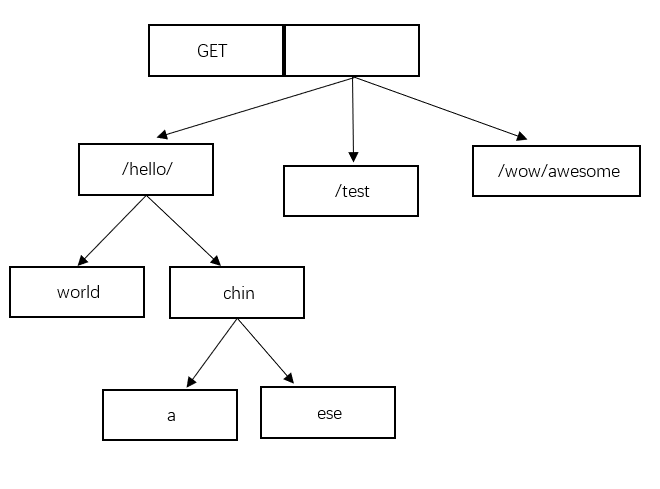
In the prefix tree of this GET method, the following routes are included:
- /wow/awesome
- /test
- /hello/world
- /hello/china
- /hello/chinese
When it comes to building this tree, you should understand that any two nodes that have the same prefix will be merged into one node.
3.2 Diagram Construction
The addRoute method mentioned above is the insertion method of this prefix tree.Assuming the present number is empty, I am going to illustrate the construction of this tree here.
Suppose we need to insert three routes:
- /hello/world
- /hello/china
- /hello/chinese
(1) Insert/hello/world
Because the tree is empty at this time, you can insert it directly:

(2) Insert/hello/china
At this point, it is found that/hello/world and/hello/china have the same prefix/hello/.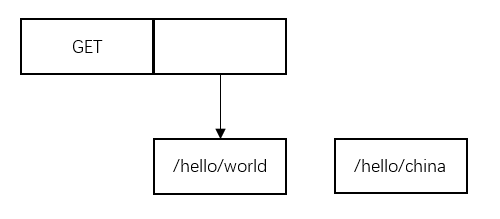
The original/hello/world node is then split, and the node to be inserted/hello/china is truncated to act as a child of/hello/world.
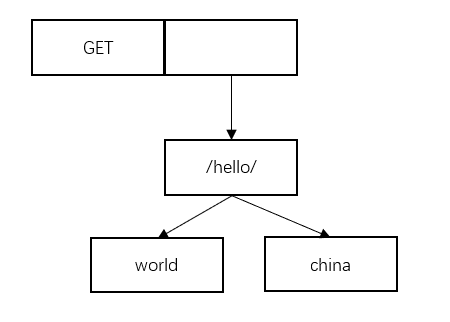
(3) Insert/hello/chinese
At this point, we need to insert/hello/Chinese, but we found that, /hello/chinese and node/hello/have a common prefix/hello/, so we'll look at the children of/hello/this node.
Notice that there is an attribute in the node called indices.It records the first letters of the child nodes of this node so that we can find them easily.For example, for this / hello / node, its indices value is wc.And the node we're going to insert is / hello/chinese, except for the public prefix, the first letter of Chinese is also c, so we're going to go into this node called china.
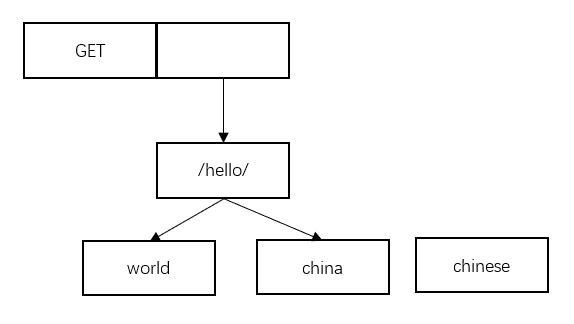
Did we find that at this point, it's back to where we started inserting / hello/china?At that time the public prefix was/hello/, and now the public prefix is chin.
So we also truncate chin as a node and a as a child of this node.Also, ese is used as a child node.
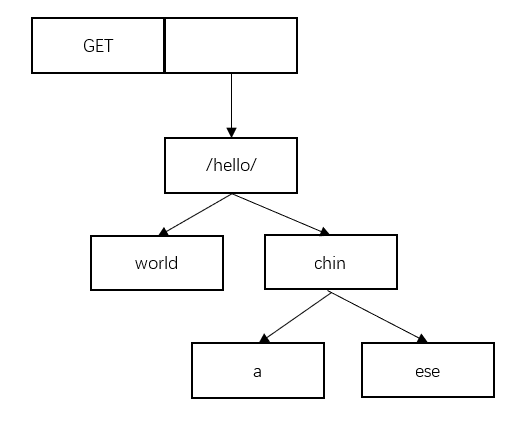
3.3 Summary Construction Algorithms
At this point, the build is over.Let's summarize the algorithm.
Specific annotated code will be given at the end of this article, and you can look at it yourself if you want to learn more.Understand the process here:
(1) If the tree is empty, insert it directly
(2) Otherwise, find out if the current node has a common prefix with the URI to insert
(3) If there is no public prefix, insert it directly
(4) If there is a common prefix, determine if the current node needs to be split
(5) If splitting is required, use the public part as the parent and the rest as the child
(6) If splitting is not required, look for children with the same prefix
(7) If the prefix is the same, skip to (4)
(8) If no prefix is the same, insert it directly
(9) At the last node, put the Handle corresponding to this route
But when we got here, some students asked: How can I route here without parameters?
In fact, as long as you understand the above process, the same is true with parameters.The logic is that before each insert, the path of the node being inserted is scanned for parameters (that is, whether the scan has or has*).If you have parameters, set the wildChild property of the current node to true, then set the parameter section to a new child node.
4 Monitoring
After we finish registering routes, let's talk about monitoring routes.
stay Last article We mentioned this in our content:
type serverHandler struct { srv *Server } func (sh serverHandler) ServeHTTP(rw ResponseWriter, req *Request) { handler := sh.srv.Handler if handler == nil { handler = DefaultServeMux } if req.RequestURI == "*" && req.Method == "OPTIONS" { handler = globalOptionsHandler{} } handler.ServeHTTP(rw, req) }
At that time, we mentioned that if we don't pass in any of the Andle methods, Golang will use the default DefaultServeMux method to process requests.Now that we've passed in a router, we'll use it to process the request.
Therefore, router also implements the ServeHTTP method.Let's take a look (some steps are also omitted):
func (r *Router) ServeHTTP(w http.ResponseWriter, req *http.Request) { ... path := req.URL.Path if root := r.trees[req.Method]; root != nil { if handle, ps, tsr := root.getValue(path, r.getParams); handle != nil { if ps != nil { handle(w, req, *ps) r.putParams(ps) } else { handle(w, req, nil) } return } } ... // Handle 404 if r.NotFound != nil { r.NotFound.ServeHTTP(w, req) } else { http.NotFound(w, req) } }
Here, we select the prefix tree corresponding to the request method and call the getValue method.
Explain this method briefly: In this method, the path in the current path and node is matched continuously until the Handle method corresponding to this route is found.
Note that during this period, if the route is RESTful and contains parameters, it will be saved in Param, where the Param structure is as follows:
type Param struct { Key string Value string }
If no corresponding route is found, the subsequent 404 method is called.
5 Processing
At this point, it's almost the same as before.
This function is called after the corresponding Handle for the route is obtained.
The only difference with the Handler used in the net/http package before is that the Handle here encapsulates the parameters obtained from the API.
type Handle func(http.ResponseWriter, *http.Request, Params)
6 Write at the end
Thank you for seeing here~
So far, httprouter has been introduced, the most critical is the construction of prefix tree.In the above I have simulated a prefix tree building process in a graphical and textual way, hoping that you can understand how the prefix tree works.Of course, if you have any questions, you can also leave a message or communicate with me in a micro-letter~
Of course, if you're not satisfied with this, you can see the appendix below, with the full code comments for the prefix tree.
Of course, the author is just getting started.So there may be a lot of omissions.If there are any inadequate explanations or errors in your understanding during the reading process, please leave a message to correct them.
Thanks again~
PS: If you have other questions, you can also find the author on the public number.Also, all articles will be updated on the Public Number at the first time. Welcome to visit the author ~

7 Source reading
7.1 Tree Structure
type node struct { path string //URI of the current node indices string //First letter of child node wildChild bool //Is Child Node a Parameter Node nType nodeType //Node Stereotypes priority uint32 //weight children []*node //Child Node handle Handle //processor }
7.2 addRoute
func (n *node) addRoute(path string, handle Handle) { fullPath := path n.priority++ // If this is an empty tree, insert it directly if len(n.path) == 0 && len(n.indices) == 0 { //This method actually inserts a path at the n node, but handles the parameters //Detailed implementation will be shown later n.insertChild(path, fullPath, handle) n.nType = root return } //Set a flag walk: for { // Find the longest prefix in the current node path and the path to insert // i is the first different subscript i := longestCommonPrefix(path, n.path) // The same part is shorter than the path recorded by this node at this time // That is, the current node needs to be split if i < len(n.path) { child := node{ // Set different parts as a slice as child nodes path: n.path[i:], wildChild: n.wildChild, nType: static, indices: n.indices, children: n.children, handle: n.handle, priority: n.priority - 1, } // Make the new node a child of this node n.children = []*node{&child} // Add the first letter of this node to indices // The goal is to find faster n.indices = string([]byte{n.path[i]}) n.path = path[:i] n.handle = nil n.wildChild = false } // At this point the same part is only part of the new URI // So set the different parts behind the path to a new node if i < len(path) { path = path[i:] // In this case, if the child node of n is parameterized if n.wildChild { n = n.children[0] n.priority++ // Determine if it will be illegal if len(path) >= len(n.path) && n.path == path[:len(n.path)] && n.nType != catchAll && (len(n.path) >= len(path) || path[len(n.path)] == '/') { continue walk } else { pathSeg := path if n.nType != catchAll { pathSeg = strings.SplitN(pathSeg, "/", 2)[0] } prefix := fullPath[:strings.Index(fullPath, pathSeg)] + n.path panic("'" + pathSeg + "' in new path '" + fullPath + "' conflicts with existing wildcard '" + n.path + "' in existing prefix '" + prefix + "'") } } // Record the first intercepted path idxc := path[0] // If the child node of n is parameterized at this time if n.nType == param && idxc == '/' && len(n.children) == 1 { n = n.children[0] n.priority++ continue walk } // This step checks to see if the split path should be merged into the child nodes // For example, see the illustration above // If so, set this child node to n and start a new cycle for i, c := range []byte(n.indices) { if c == idxc { // This part is to adjust the higher weight first character to the front i = n.incrementChildPrio(i) n = n.children[i] continue walk } } // If this node does not need to be merged if idxc != ':' && idxc != '*' { // Add the first letter of this node to the indices of n n.indices += string([]byte{idxc}) child := &node{} n.children = append(n.children, child) n.incrementChildPrio(len(n.indices) - 1) // Create a new node n = child } // Insert this node n.insertChild(path, fullPath, handle) return } // Insert directly into the current node if n.handle != nil { panic("a handle is already registered for path '" + fullPath + "'") } n.handle = handle return } }
7.3 insertChild
func (n *node) insertChild(path, fullPath string, handle Handle) { for { // This method is used to find out if the path contains parameters wildcard, i, valid := findWildcard(path) // Without parameters, jump out of the loop and look at the last two lines if i < 0 { break } // Conditional Check if !valid { panic("only one wildcard per path segment is allowed, has: '" + wildcard + "' in path '" + fullPath + "'") } // Similarly determine legality if len(wildcard) < 2 { panic("wildcards must be named with a non-empty name in path '" + fullPath + "'") } if len(n.children) > 0 { panic("wildcard segment '" + wildcard + "' conflicts with existing children in path '" + fullPath + "'") } // If the first bit of the parameter is `:`, then this is a parameter type if wildcard[0] == ':' { if i > 0 { // Set the current path to the part before the parameter n.path = path[:i] // Ready to use the part after the parameter as a new node path = path[i:] } //Then the parameter part is used as the new node n.wildChild = true child := &node{ nType: param, path: wildcard, } n.children = []*node{child} n = child n.priority++ // This means that the path does not end after the parameter if len(wildcard) < len(path) { // Divide the part after the parameter into another node and continue continues path = path[len(wildcard):] child := &node{ priority: 1, } n.children = []*node{child} n = child continue } // Set Processor In n.handle = handle return } else { // Another case if i+len(wildcard) != len(path) { panic("catch-all routes are only allowed at the end of the path in path '" + fullPath + "'") } if len(n.path) > 0 && n.path[len(n.path)-1] == '/' { panic("catch-all conflicts with existing handle for the path segment root in path '" + fullPath + "'") } // Determine if there is one/ i-- if path[i] != '/' { panic("no / before catch-all in path '" + fullPath + "'") } n.path = path[:i] // Set a child node of catchAll type child := &node{ wildChild: true, nType: catchAll, } n.children = []*node{child} n.indices = string('/') n = child n.priority++ // Set the latter parameter section to the new node child = &node{ path: path[i:], nType: catchAll, handle: handle, priority: 1, } n.children = []*node{child} return } } // For the first part, if there are no parameters in this path, set it directly n.path = path n.handle = handle }
The key ways are all over here. Applause the people who see it!
This part of the understanding will be more difficult and may need to be read a few more times.
If there is still something difficult to understand, please leave a message to exchange, or come directly to the public number to find me~
